Thermo-mechanical NTFA - results of the CMAME article
Felix Fritzen fritzen@simtech.uni-stuttgart.de, Julius Herb julius.herb@mib.uni-stuttgart.de, Shadi Sharba shadi.sharba@isc.fraunhofer.de
University of Stuttgart, Institute of Applied Mechanics, Chair for Data Analytics in Engineering
Funding acknowledgment The IGF-Project no.: 21.079 N / DVS-No.: 06.3341 of the “Forschungsvereinigung Schweißen und verwandte Verfahren e.V.” of the German Welding Society (DVS), Aachener Str. 172, 40223 Düsseldorf, Germany, was funded by the Federal Ministry for Economic Affairs and Climate Action (BMWK) via the German Federation of Industrial Research Associations (AiF) in accordance with the policy to support the Industrial Collective Research (IGF) on the orders of the German Bundestag.
Felix Fritzen is funded by the German Research Foundation (DFG) – 390740016 (EXC-2075); 406068690 (FR2702/8-1); 517847245 (FR2702/10-1).
This notebooks reproduces some results and plots from the examples of our CMAME article.
Imports:
[1]:
import os
import h5py
import matplotlib
import matplotlib.pyplot as plt
from matplotlib import cm
from matplotlib.colors import LightSource
from material_parameters import *
from thermontfa import TabularInterpolation, ThermoMechNTFA
plt.rcParams["figure.dpi"] = 400
# matplotlib.rc("font", size=8)
colors = [
"#004191",
"#00BEFF",
"tab:orange",
"tab:red",
"tab:olive",
"tab:green",
"tab:brown",
"tab:pink",
"tab:gray",
"tab:cyan",
"tab:purple",
"tab:blue",
]
markers = ["o", "d", "s", "+", "^", "x", "p", "*", "v", "1", "P", "."]
plot_width = 2 * 4.68596
matplotlib.rcParams["axes.prop_cycle"] = matplotlib.cycler(color=colors)
data_path = "../data"
def Vec2Tensor(vec):
"""Convert a 6-vector (in Mandel notation) into a sym. 3x3 Matrix"""
A = np.zeros((3, 3))
A[0, 0] = vec[0]
A[1, 1] = vec[1]
A[2, 2] = vec[2]
A[0, 1] = np.sqrt(0.5) * vec[3]
A[1, 0] = A[0, 1]
A[0, 2] = np.sqrt(0.5) * vec[4]
A[2, 0] = A[0, 2]
A[1, 2] = np.sqrt(0.5) * vec[5]
A[2, 1] = A[1, 2]
return A
def rel_error(A, A_ref, r_min=None):
if r_min is None:
return np.linalg.norm(A - A_ref, axis=1) / np.linalg.norm(A_ref, axis=1)
else:
return np.linalg.norm(A - A_ref, axis=1) / (
np.maximum(r_min, np.linalg.norm(A_ref, axis=1))
)
Load the NTFA data
Read the tabularized data for all operators individually
This also happens inside of the ThermoNTFA class during initialization
[2]:
mode_fn = os.path.join(data_path, "rve", "rve_thermoplastic_6loadings_10samples.h5")
A_bar = TabularInterpolation.from_h5(
mode_fn,
"/ms_9p/dset0_ntfa/temperatures",
"/ms_9p/dset0_ntfa/A_bar",
transpose_dims=(2, 0, 1),
)
C_bar = TabularInterpolation.from_h5(
mode_fn,
"/ms_9p/dset0_ntfa/temperatures",
"/ms_9p/dset0_ntfa/C_bar",
transpose_dims=(2, 0, 1),
)
A_cu = TabularInterpolation.from_h5(
mode_fn,
"/ms_9p/dset0_ntfa/temperatures",
"/ms_9p/dset0_ntfa/A0",
transpose_dims=(2, 0, 1),
)
A_ftc = TabularInterpolation.from_h5(
mode_fn,
"/ms_9p/dset0_ntfa/temperatures",
"/ms_9p/dset0_ntfa/A1",
transpose_dims=(2, 0, 1),
)
C_cu = TabularInterpolation.from_h5(
mode_fn,
"/ms_9p/dset0_ntfa/temperatures",
"/ms_9p/dset0_ntfa/C0",
transpose_dims=(2, 0, 1),
)
C_ftc = TabularInterpolation.from_h5(
mode_fn,
"/ms_9p/dset0_ntfa/temperatures",
"/ms_9p/dset0_ntfa/C1",
transpose_dims=(2, 0, 1),
)
# number of modes - needed to truncate A!
N_modes = 24
A_bar.data = A_bar.data[:, :, :N_modes]
A_cu.data = A_cu.data[:, :, : (7 + N_modes)]
A_ftc.data = A_ftc.data[:, :, : (7 + N_modes)]
for A in [A_bar, A_cu, A_ftc]:
A.dim = A.data.shape
Training reproduction tests
Analysis of the training directions of the temperature range
Load data from hdf5 files
compare efficiency of the interpolation over the temperature
show select stress-strain curves
results are generated based on
generate_inputs.pyand external C/C++ UMAT
[3]:
data_sig_ntfa = np.zeros((3, 3, 3, 11, 6))
data_sig_fans = np.zeros((3, 3, 3, 11, 6))
line_style = [
{"linewidth": 2, "color": colors[0], "linestyle": "solid", "markersize": 6},
{"linewidth": 2, "color": colors[1], "linestyle": "dashed", "markersize": 6},
{"linewidth": 2, "color": colors[3], "linestyle": "dotted", "markersize": 6},
]
for i, N_modes in enumerate((12, 18, 24)):
fname = f"all_results_ms9p_16x16x16_100s_N{N_modes}.h5"
fname = os.path.join(
data_path, "results", f"reproduction_6loadings_100samples_N{N_modes}.h5"
)
with h5py.File(fname, "r") as F:
eps = np.array(F["/eps"])
theta = np.array(F["/temperature"])
fans_sig = np.array(F["/fans/sig"])
fans_sig_cu = np.array(F["/fans/sig0"])
fans_sig_ftc = np.array(F["/fans/sig1"])
ntfa_sig = np.array(F["/ntfa/sig"])
ntfa_sig_cu = np.array(F["/ntfa/sig0"])
ntfa_sig_ftc = np.array(F["/ntfa/sig1"])
ntfa_q = np.array(F["/ntfa/q"])
ntfa_xi = np.array(F["/ntfa/xi"])
print(i)
print(eps[0, 1, -1, :])
data_sig_ntfa[0, 0, i, :, :] = ntfa_sig[0, 2, :, :]
data_sig_ntfa[1, 0, i, :, :] = ntfa_sig[0, 1, :, :]
data_sig_ntfa[2, 0, i, :, :] = ntfa_sig[0, 5, :, :]
data_sig_ntfa[0, 1, i, :, :] = ntfa_sig[33, 2, :, :]
data_sig_ntfa[1, 1, i, :, :] = ntfa_sig[33, 1, :, :]
data_sig_ntfa[2, 1, i, :, :] = ntfa_sig[33, 5, :, :]
data_sig_ntfa[0, 2, i, :, :] = ntfa_sig[-1, 2, :, :]
data_sig_ntfa[1, 2, i, :, :] = ntfa_sig[-1, 1, :, :]
data_sig_ntfa[2, 2, i, :, :] = ntfa_sig[-1, 5, :, :]
data_sig_fans[0, 0, i, :, :] = fans_sig[0, 2, :, :]
data_sig_fans[1, 0, i, :, :] = fans_sig[0, 1, :, :]
data_sig_fans[2, 0, i, :, :] = fans_sig[0, 5, :, :]
data_sig_fans[0, 1, i, :, :] = fans_sig[33, 2, :, :]
data_sig_fans[1, 1, i, :, :] = fans_sig[33, 1, :, :]
data_sig_fans[2, 1, i, :, :] = fans_sig[33, 5, :, :]
data_sig_fans[0, 2, i, :, :] = fans_sig[-1, 2, :, :]
data_sig_fans[1, 2, i, :, :] = fans_sig[-1, 1, :, :]
data_sig_fans[2, 2, i, :, :] = fans_sig[-1, 5, :, :]
0
[ 0. 0.01414214 -0.01414214 0. 0. 0. ]
1
[ 0. 0.01414214 -0.01414214 0. 0. 0. ]
2
[ 0. 0.01414214 -0.01414214 0. 0. 0. ]
Analysis of the training directions of the temperature range
First figure: comparison of \(\theta\)-NTFA and FEM for training scenarios
loadcases: 0, 2, 5
temperatures: 0, 3, 9 (0, 33, -1)
N_modes: 12, 18, 24
Relative error in sig_bar for 300K, 633.3K and 1300 K
[4]:
fig, ax = plt.subplots(1, 3, figsize=(plot_width, 3.25))
Temp = [theta[0], theta[33], theta[-1]]
load = np.linspace(0, 1, 11)
m = ["o", "d", "s"]
P2 = np.eye(6)
J_load = (3, 2, 6)
for i_mode in range(3):
N_modes = (12, 18, 24)[i_mode]
for i_load in range(3):
for i_temp in range(3):
T = Temp[i_temp]
s = data_sig_fans[i_temp, i_load, i_mode, :, :] @ P2
ds = data_sig_ntfa[i_temp, i_load, i_mode, :, :] @ P2 - s
err = np.linalg.norm(ds, axis=1) / np.linalg.norm(s, axis=1) * 100.0
if i_temp == 0:
ax[i_temp].plot(
load[1:],
err[1:],
label=f"N={N_modes}, load={J_load[i_load]}",
**line_style[i_mode],
marker=m[i_load],
)
else:
ax[i_temp].plot(
load[1:], err[1:], **line_style[i_mode], marker=m[i_load]
)
for a in ax:
# a.legend()
a.grid()
a.set_xlabel("relative loading [-]")
a.set_ylabel(r"relative error in $\overline{\mathbf{\sigma}}$ [%]")
fig.legend(ncol=3, loc="lower center", bbox_to_anchor=(0, -0.2, 1, 1))
ax[0].set_title(r"comparison for $T=$300 K")
ax[1].set_title(r"comparison for $T=$633.3 K")
ax[2].set_title(r"comparison for $T=$1300 K")
fig.tight_layout()
fig.savefig(
os.path.join(data_path, "figures", "training_reproduction.pdf"), bbox_inches="tight"
)
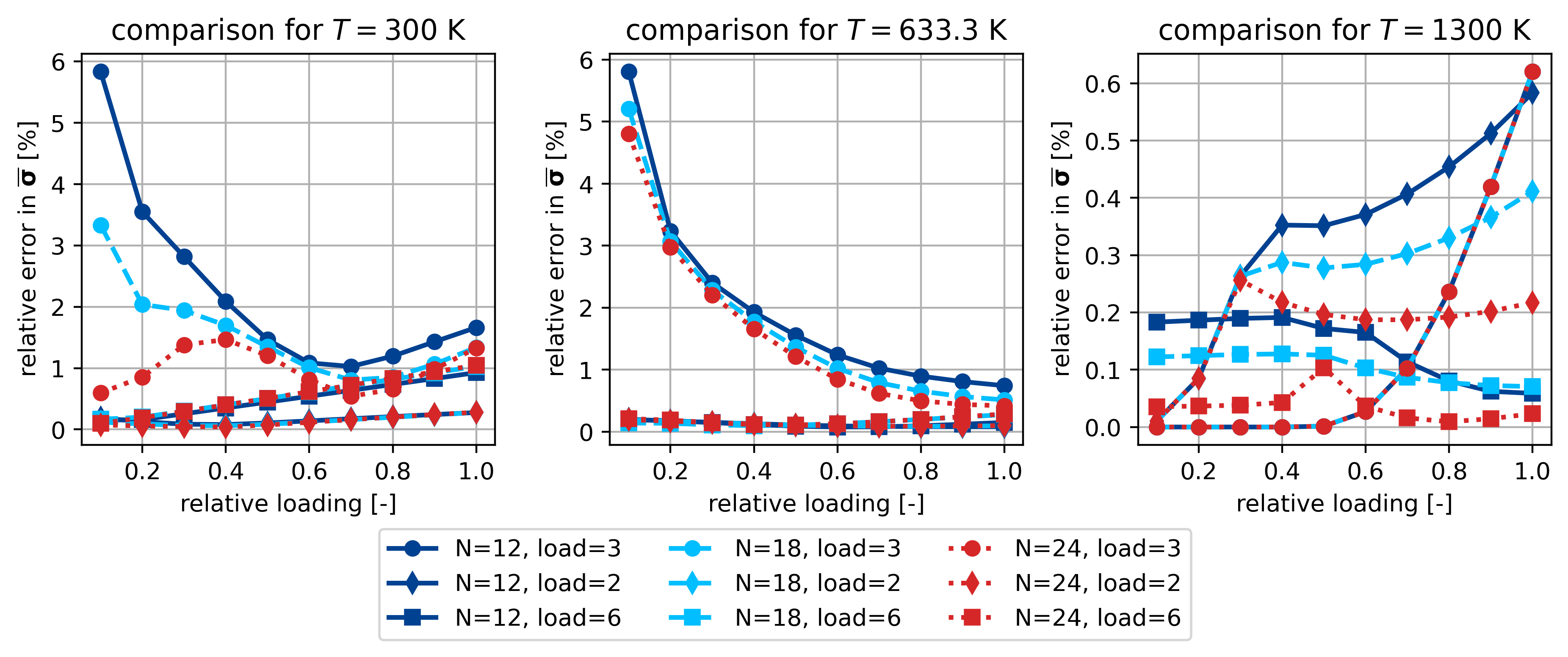
Training reproduction tests
Analysis of the training directions of the temperature range
Load data from hdf5 file
compare efficiency of the interpolation over the temperature
show select stress-strain curves
results are generated based on
generate_inputs.pyand external C/C++ UMAT
[5]:
fname = os.path.join(
data_path, "results", f"reproduction_6loadings_100samples_N{N_modes}.h5"
)
with h5py.File(fname, "r") as F:
eps = np.array(F["/eps"])
theta = np.array(F["/temperature"])
fans_sig = np.array(F["/fans/sig"])
fans_sig_cu = np.array(F["/fans/sig0"])
fans_sig_ftc = np.array(F["/fans/sig1"])
ntfa_sig = np.array(F["/ntfa/sig"])
ntfa_sig_cu = np.array(F["/ntfa/sig0"])
ntfa_sig_ftc = np.array(F["/ntfa/sig1"])
ntfa_q = np.array(F["/ntfa/q"])
ntfa_xi = np.array(F["/ntfa/xi"])
Relative error in sig_bar for 300 and 1300 K
[6]:
fig, axx = plt.subplots(1, 2, figsize=(plot_width, 3.5))
ct = 0
first_plot = True
for i_T, T in zip((0, 9), (300.0, 1300.0)):
ax = axx[ct]
ct += 1
ax.set_title(r"rel. error in $\overline{\sigma}$, T=%.1f K" % T)
x = np.linspace(0, 1, 11)
ax.set_xlabel("rel. load [-]")
ax.set_ylabel(r"rel. error in $\overline{\sigma}$ [%]")
for iload in range(6):
myerr = (
np.linalg.norm(
fans_sig[i_T][iload][:, :] - ntfa_sig[i_T][iload][:, :], axis=1
)
* 100.0
/ np.linalg.norm(fans_sig[i_T][iload][:, :], axis=1)
)
if first_plot:
ax.plot(
x,
myerr,
lw=2,
label=f"load {iload+1}",
color=colors[iload],
marker=markers[iload],
)
else:
ax.plot(x, myerr, lw=2, color=colors[iload], marker=markers[iload])
# ax.legend()
ax.grid()
first_plot = False
fig.legend(ncol=6, loc="lower center", bbox_to_anchor=(0, -0.07, 1, 1))
fig.tight_layout()
fig.savefig(
os.path.join(data_path, "figures", "rel_err_sig_10s.pdf"),
format="pdf",
bbox_inches="tight",
)
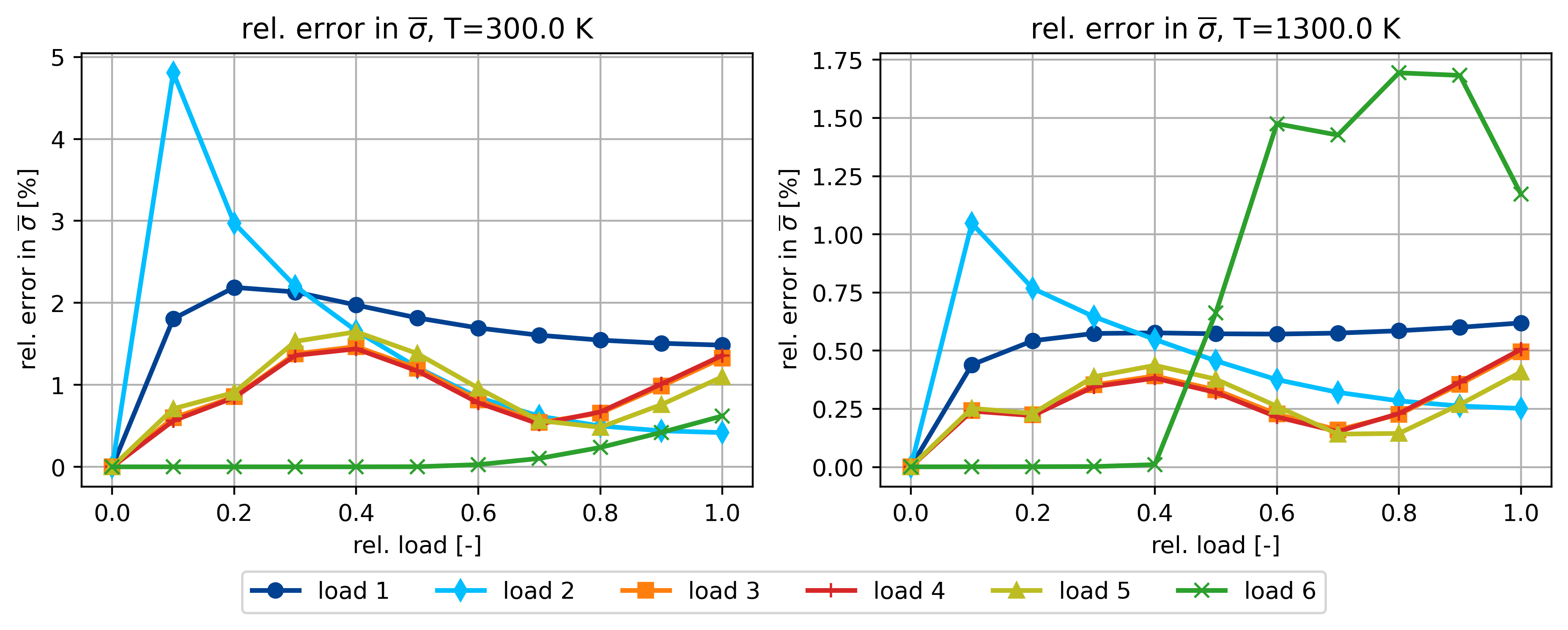
[7]:
fig, axx = plt.subplots(1, 2, figsize=(plot_width, 3.5))
ct = 0
first_plot = True
for i_T, T in zip((0, 9), (300.0, 1300.0)):
ax = axx[ct]
ct += 1
ax.set_title(r"rel. error in $\overline{\sigma}_{\rm FTC}$, T=%.1f K" % T)
x = np.linspace(0, 1, 11)
ax.set_xlabel("rel. load [-]")
ax.set_ylabel(r"rel. error in $\overline{\sigma}_{\sf FTC}$ [%]")
for iload in range(6):
myerr = (
np.linalg.norm(
fans_sig_ftc[i_T][iload][:, :] - ntfa_sig_ftc[i_T][iload][:, :], axis=1
)
* 100.0
/ np.linalg.norm(fans_sig_ftc[i_T][iload][:, :], axis=1)
)
if first_plot:
ax.plot(
x,
myerr,
lw=2,
label=f"load {iload+1}",
color=colors[iload],
marker=markers[iload],
)
else:
ax.plot(x, myerr, lw=2, color=colors[iload], marker=markers[iload])
# ax.legend()
ax.grid()
first_plot = False
fig.legend(ncol=6, loc="lower center", bbox_to_anchor=(0, -0.07, 1, 1))
fig.tight_layout()
fig.savefig(
os.path.join(data_path, "figures", "rel_err_sig_ftc_10s.pdf"),
format="pdf",
bbox_inches="tight",
)
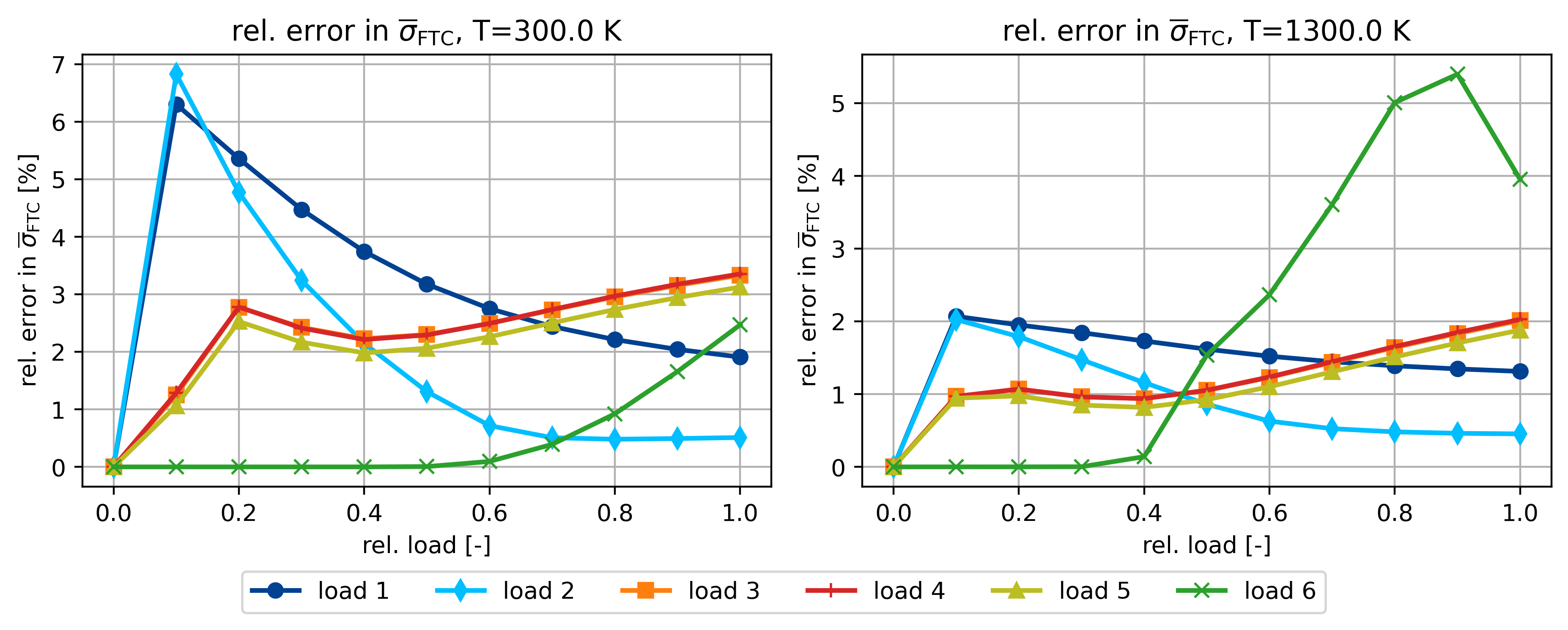
Plot the for loadcase no. 2 relevant curves
[8]:
err = np.zeros((theta.size, fans_sig.shape[2]))
err0 = np.zeros_like(err)
err1 = np.zeros_like(err)
err_h = np.zeros_like(err)
err_eq = np.zeros_like(err)
zeta = np.zeros((eps.shape[2], ntfa_xi.shape[-1] + 7))
iload = 2
for i_T, T in enumerate(theta):
Sref = fans_sig[i_T, iload]
Sref0 = fans_sig_cu[i_T, iload]
Sref1 = fans_sig_ftc[i_T, iload]
# recompute stress of NTFA:
zeta[:, :6] = eps[i_T, iload]
zeta[:, 6] = 1
zeta[:, 7:] = ntfa_xi[i_T, iload]
ntfa_S0 = zeta @ (A_cu.interpolate(T)).T
ntfa_S1 = zeta @ (A_ftc.interpolate(T)).T
dS = Sref - ntfa_sig[i_T, iload, :, :]
dS0 = Sref0 - ntfa_S0
dS1 = Sref1 - ntfa_S1
# errors in %
err[i_T, :] = np.linalg.norm(dS, axis=1) / np.linalg.norm(Sref, axis=1) * 100
err0[i_T, :] = np.linalg.norm(dS0, axis=1) / np.linalg.norm(Sref0, axis=1) * 100
err1[i_T, :] = np.linalg.norm(dS1, axis=1) / np.linalg.norm(Sref1, axis=1) * 100
# in MPa:
err_h[i_T, :] = dS[:, :3].sum(axis=1) / 3.0 / 1000.0
err_eq[i_T, :] = (
np.maximum(0, np.linalg.norm(dS, axis=1) ** 2 - 3 * err_h[i_T, :] ** 2)
* np.sqrt(1.5)
/ 1000.0
)
3D Plots
[9]:
X = np.linspace(0, 1, fans_sig.shape[2])
Y = theta
XX, YY = np.meshgrid(X, Y)
fig, ax = plt.subplots(
1, 2, subplot_kw=dict(projection="3d"), figsize=(plot_width, 4.5)
)
ls = LightSource(220, 45)
ZZ = err
rgb = ls.shade(ZZ, cmap=cm.jet, vert_exag=0.1, blend_mode="soft")
ax[0].view_init(elev=45, azim=-30)
surf = ax[0].plot_surface(
XX,
YY,
ZZ,
rstride=1,
cstride=1,
facecolors=rgb,
linewidth=0,
antialiased=False,
shade=False,
)
ax[0].set_xlabel("rel. load [-]")
ax[0].set_ylabel("temperature [K]")
ax[0].set_zlabel(r"rel. error in $\overline{\sigma}$ [%]")
fig.tight_layout()
ax[0].set_title(r"load case 2, rel. errors in $\overline{\sigma}$")
ax[0].zaxis.labelpad = 0.1
ax[0].set_box_aspect(aspect=None, zoom=0.83)
ZZ = err1
rgb = ls.shade(ZZ, cmap=cm.jet, vert_exag=0.1, blend_mode="soft")
ax[1].view_init(elev=45, azim=-30)
surf = ax[1].plot_surface(
XX,
YY,
ZZ,
rstride=1,
cstride=1,
facecolors=rgb,
linewidth=0,
antialiased=False,
shade=False,
)
ax[1].set_xlabel("rel. load [-]")
ax[1].set_ylabel("temperature [K]")
ax[1].set_zlabel(r"rel. error in $\overline{\sigma}_{\sf FTC}$ [%]")
ax[1].set_title(r"load case 2, rel. errors in $\overline{\sigma}_{\sf FTC}$")
ax[1].zaxis.labelpad = 0.1
ax[1].set_box_aspect(aspect=None, zoom=0.83)
# plt.subplots_adjust(right=0.1)
fig.tight_layout()
plt.autoscale()
fig.savefig(
os.path.join(data_path, "figures", "surface_plots_err_sig_sig_ftc.pdf"),
format="pdf",
)
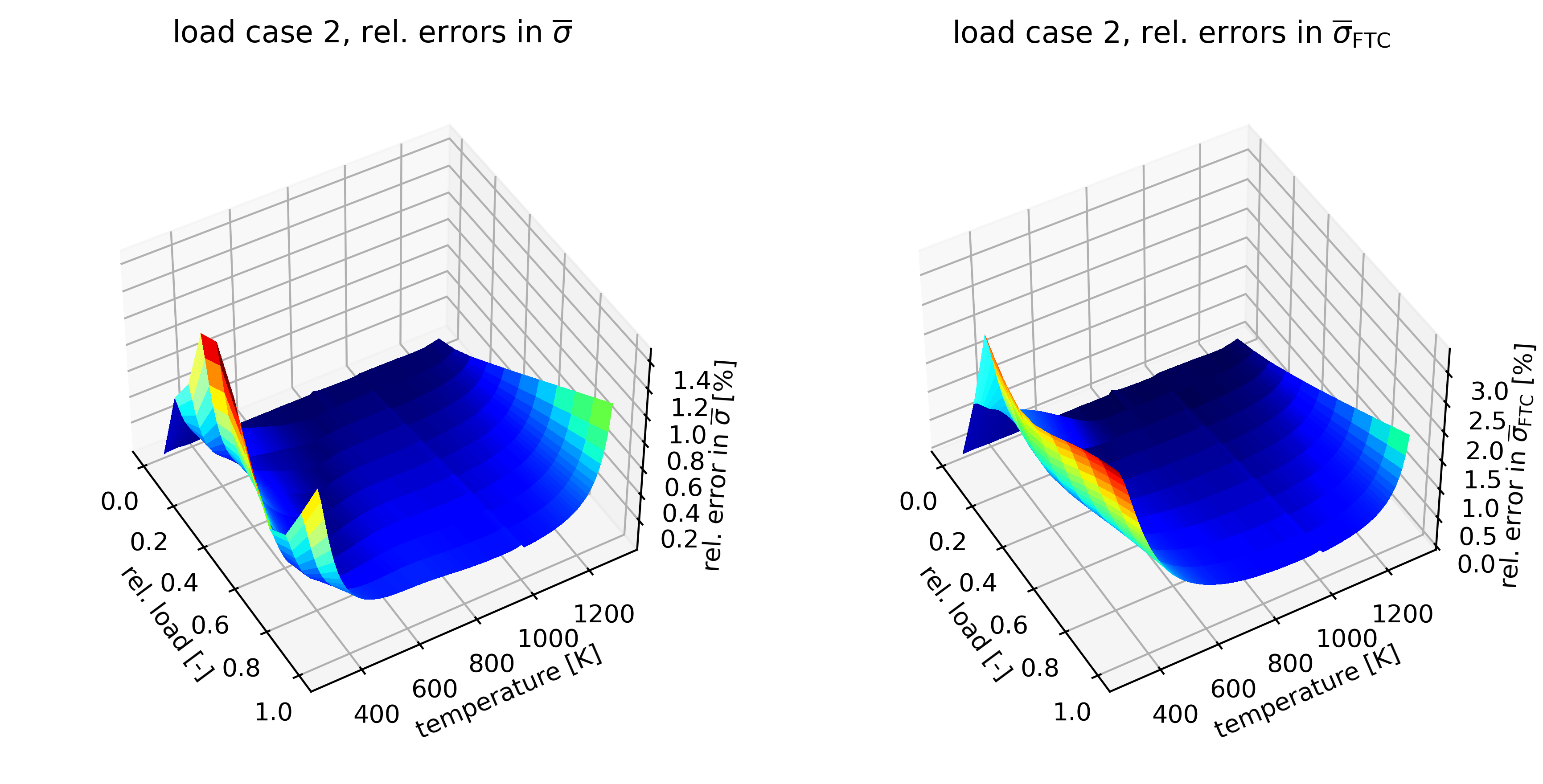
Random loading
[10]:
file_name = os.path.join(data_path, "ntfa", "ntfa_6loadings_10samples_N24.h5")
ntfa_material = ThermoMechNTFA(file_name, group_name="/", sig_y=my_sig_y, N_max=24)
loadings_file_name = os.path.join(
data_path, "loadcases", "random_loadings_vol1e-3_dev2e-2_paper_10increments.h5"
)
with h5py.File(loadings_file_name, "r") as F:
# load the random loadings from file and run NTFA; compare to full model
eps_rand = np.array(F["/eps_random"][:3, :])
fig, ax = plt.subplots(2, 3, figsize=(plot_width, 6.0))
for i_load, E in enumerate(eps_rand):
for i_temp, T in enumerate(("0355.6", "0688.9", "1022.2")):
ntfa_e = np.zeros((11, 6))
ntfa_s = np.zeros((11, 6))
ntfa_s_ftc = np.zeros((11, 6))
ntfa_xi = np.zeros((11, ntfa_material.n_modes))
ntfa_q = np.zeros(11)
theta = float(T)
ntfa_material.interpolate(theta)
e = np.zeros(6)
de = np.zeros(6)
s = np.zeros(6)
xi = np.zeros(ntfa_material.n_modes)
q = 0.0
i_inc = 0
# initial purely thermal step:
s, q, xi, C = ntfa_material.solve(e, de, theta, q, xi)
ntfa_s[i_inc, :] = s
ntfa_e[i_inc, :] = e
ntfa_q[i_inc] = q
ntfa_s_ftc[i_inc, :] = ntfa_material.stress(e, theta, xi, i_phase=1)
i_inc += 1
print("# -----------------------------------------------------")
print(f"# theta {theta:6.1f} K, load direction {E}")
print(f"# q_initial = {100*q:6.2f}%")
rel_load = np.linspace(0, 1, 11)
for rl in rel_load[1:]:
e_old = e
e = E * rl
de = e - e_old
s, q, xi, C = ntfa_material.solve(e, de, theta, q, xi)
ntfa_s[i_inc, :] = s
ntfa_e[i_inc, :] = e
ntfa_q[i_inc] = q
ntfa_s_ftc[i_inc, :] = ntfa_material.stress(e, theta, xi, i_phase=1)
i_inc += 1
s_ref = np.array(F[f"loading{i_load}/ntfa_T{T}/fe_sig"])
s_ftc_ref = np.array(F[f"loading{i_load}/ntfa_T{T}/fe_sig1"])
print("rel. error in sigma: ", rel_error(ntfa_s, s_ref))
print("rel. error in sigma_FTC: ", rel_error(ntfa_s_ftc, s_ftc_ref))
if i_load == 0:
ax[0, i_load].plot(
rel_load,
rel_error(ntfa_s, s_ref) * 100,
**line_style[i_temp],
marker=m[i_temp],
label=rf"$\theta$={theta} K",
)
else:
ax[0, i_load].plot(
rel_load,
rel_error(ntfa_s, s_ref) * 100,
**line_style[i_temp],
marker=m[i_temp],
)
ax[0, i_load].set_ylabel(r"rel. error in $\overline{\sigma}$ [%]")
ax[0, i_load].set_xlabel(r"rel. loading [-]")
ax[1, i_load].set_ylabel(r"rel. error in $\overline{\sigma}_{\sf FTC}$ [%]")
ax[1, i_load].set_xlabel(r"rel. loading [-]")
ax[1, i_load].plot(
rel_load,
rel_error(ntfa_s_ftc, s_ftc_ref) * 100,
**line_style[i_temp],
marker=m[i_temp],
)
ax[0, 0].set_title(r"rel. error in $\overline{\sigma}$, rand. load. 1")
ax[0, 1].set_title(r"rel. error in $\overline{\sigma}$, rand. load. 2")
ax[0, 2].set_title(r"rel. error in $\overline{\sigma}$, rand. load. 3")
ax[1, 0].set_title(r"rel. error in $\overline{\sigma}_\mathsf{FTC}$, rand. load. 1")
ax[1, 1].set_title(r"rel. error in $\overline{\sigma}_\mathsf{FTC}$, rand. load. 2")
ax[1, 2].set_title(r"rel. error in $\overline{\sigma}_\mathsf{FTC}$, rand. load. 3")
for a in ax.ravel():
a.grid()
fig.tight_layout()
fig.legend(ncol=3, loc="lower center", bbox_to_anchor=(0, -0.05, 1, 1))
fig.savefig(
os.path.join(data_path, "figures", "random_loading.pdf"), bbox_inches="tight"
)
# -----------------------------------------------------
# theta 355.6 K, load direction [ 0.01345955 0.00120596 -0.01442758 -0.00174739 -0.00209628 -0.00134247]
# q_initial = 0.00%
rel. error in sigma: [0.00079347 0.01325923 0.01833459 0.02559488 0.03093237 0.03274888
0.03258824 0.0317404 0.03077862 0.02992804 0.02925927]
rel. error in sigma_FTC: [0.00079481 0.02919058 0.04193925 0.05161598 0.05739231 0.05805257
0.05620802 0.05365624 0.05110733 0.048793 0.04676408]
# -----------------------------------------------------
# theta 688.9 K, load direction [ 0.01345955 0.00120596 -0.01442758 -0.00174739 -0.00209628 -0.00134247]
# q_initial = 0.00%
rel. error in sigma: [3.08375402e-05 2.00375348e-03 2.42283629e-03 2.33070212e-03
2.22530685e-03 2.19487064e-03 2.22543239e-03 2.29234515e-03
2.37875831e-03 2.47497693e-03 2.57577080e-03]
rel. error in sigma_FTC: [1.47238813e-05 4.24959542e-03 5.22217961e-03 5.16668490e-03
5.06708409e-03 5.06360790e-03 5.12948561e-03 5.23074834e-03
5.34816422e-03 5.47281335e-03 5.60099760e-03]
# -----------------------------------------------------
# theta 1022.2 K, load direction [ 0.01345955 0.00120596 -0.01442758 -0.00174739 -0.00209628 -0.00134247]
# q_initial = 0.24%
rel. error in sigma: [2.48542149e-05 1.37106842e-04 2.29766833e-04 3.23282875e-04
4.18719314e-04 5.14931971e-04 6.11730325e-04 7.09285781e-04
8.07161709e-04 9.05358274e-04 1.00383456e-03]
rel. error in sigma_FTC: [2.33147125e-05 2.88254524e-04 4.32868148e-04 5.98013360e-04
7.77216791e-04 9.63321375e-04 1.15312257e-03 1.34583278e-03
1.53995666e-03 1.73513587e-03 1.93107790e-03]
# -----------------------------------------------------
# theta 355.6 K, load direction [ 0.00689357 -0.00933564 0.00308958 0.00825303 0.01254929 0.0055065 ]
# q_initial = 0.00%
rel. error in sigma: [0.00079347 0.00903763 0.01360196 0.0173945 0.02081243 0.02390367
0.02660862 0.02893536 0.03091273 0.03258693 0.03401001]
rel. error in sigma_FTC: [0.00079481 0.02688928 0.02861313 0.03267052 0.03496063 0.03627792
0.03713389 0.03772806 0.0381202 0.03835118 0.03846689]
# -----------------------------------------------------
# theta 688.9 K, load direction [ 0.00689357 -0.00933564 0.00308958 0.00825303 0.01254929 0.0055065 ]
# q_initial = 0.00%
rel. error in sigma: [3.08375402e-05 1.44334650e-03 1.49171330e-03 1.75034214e-03
1.99382665e-03 2.21420886e-03 2.42534627e-03 2.63701485e-03
2.85372645e-03 3.07681104e-03 3.30616577e-03]
rel. error in sigma_FTC: [1.47238813e-05 2.86007789e-03 2.53701425e-03 2.96419214e-03
3.37995727e-03 3.76664335e-03 4.16270670e-03 4.58757618e-03
5.04263367e-03 5.52147954e-03 6.01655543e-03]
# -----------------------------------------------------
# theta 1022.2 K, load direction [ 0.00689357 -0.00933564 0.00308958 0.00825303 0.01254929 0.0055065 ]
# q_initial = 0.24%
rel. error in sigma: [2.48542149e-05 2.39496068e-04 4.44409558e-04 6.47045014e-04
8.50042886e-04 1.05374007e-03 1.25858753e-03 1.46435002e-03
1.67110136e-03 1.87884675e-03 2.08709830e-03]
rel. error in sigma_FTC: [2.33147125e-05 4.04571603e-04 7.90733945e-04 1.18214257e-03
1.57558802e-03 1.97047622e-03 2.36754849e-03 2.76629644e-03
3.16683934e-03 3.56916585e-03 3.97260097e-03]
# -----------------------------------------------------
# theta 355.6 K, load direction [-0.00489279 0.00177814 0.00402877 -0.00165031 -0.00195194 0.01871931]
# q_initial = 0.00%
rel. error in sigma: [0.00079347 0.00727033 0.01474287 0.01952497 0.0232464 0.02623473
0.02875269 0.03097249 0.03301372 0.03493435 0.03675783]
rel. error in sigma_FTC: [0.00079481 0.02042171 0.02706764 0.03077326 0.03250681 0.03393666
0.03540338 0.03680951 0.03808579 0.03920043 0.04015964]
# -----------------------------------------------------
# theta 688.9 K, load direction [-0.00489279 0.00177814 0.00402877 -0.00165031 -0.00195194 0.01871931]
# q_initial = 0.00%
rel. error in sigma: [3.08375402e-05 1.20952767e-03 1.50237782e-03 1.73649087e-03
1.94739539e-03 2.16581857e-03 2.39518314e-03 2.63528977e-03
2.88544819e-03 3.14482681e-03 3.41266024e-03]
rel. error in sigma_FTC: [1.47238813e-05 2.38259633e-03 2.29123761e-03 2.76498675e-03
3.21780839e-03 3.68187758e-03 4.16921619e-03 4.68161669e-03
5.21582280e-03 5.76734763e-03 6.33238845e-03]
# -----------------------------------------------------
# theta 1022.2 K, load direction [-0.00489279 0.00177814 0.00402877 -0.00165031 -0.00195194 0.01871931]
# q_initial = 0.24%
rel. error in sigma: [2.48542149e-05 2.65603158e-04 4.91073003e-04 7.18824248e-04
9.47664163e-04 1.17807306e-03 1.41000618e-03 1.64348548e-03
1.87758997e-03 2.11482464e-03 2.35317889e-03]
rel. error in sigma_FTC: [2.33147125e-05 4.79222843e-04 9.03795659e-04 1.33771760e-03
1.77383707e-03 2.21269690e-03 2.65406028e-03 3.09811699e-03
3.54367330e-03 3.99420901e-03 4.44692243e-03]
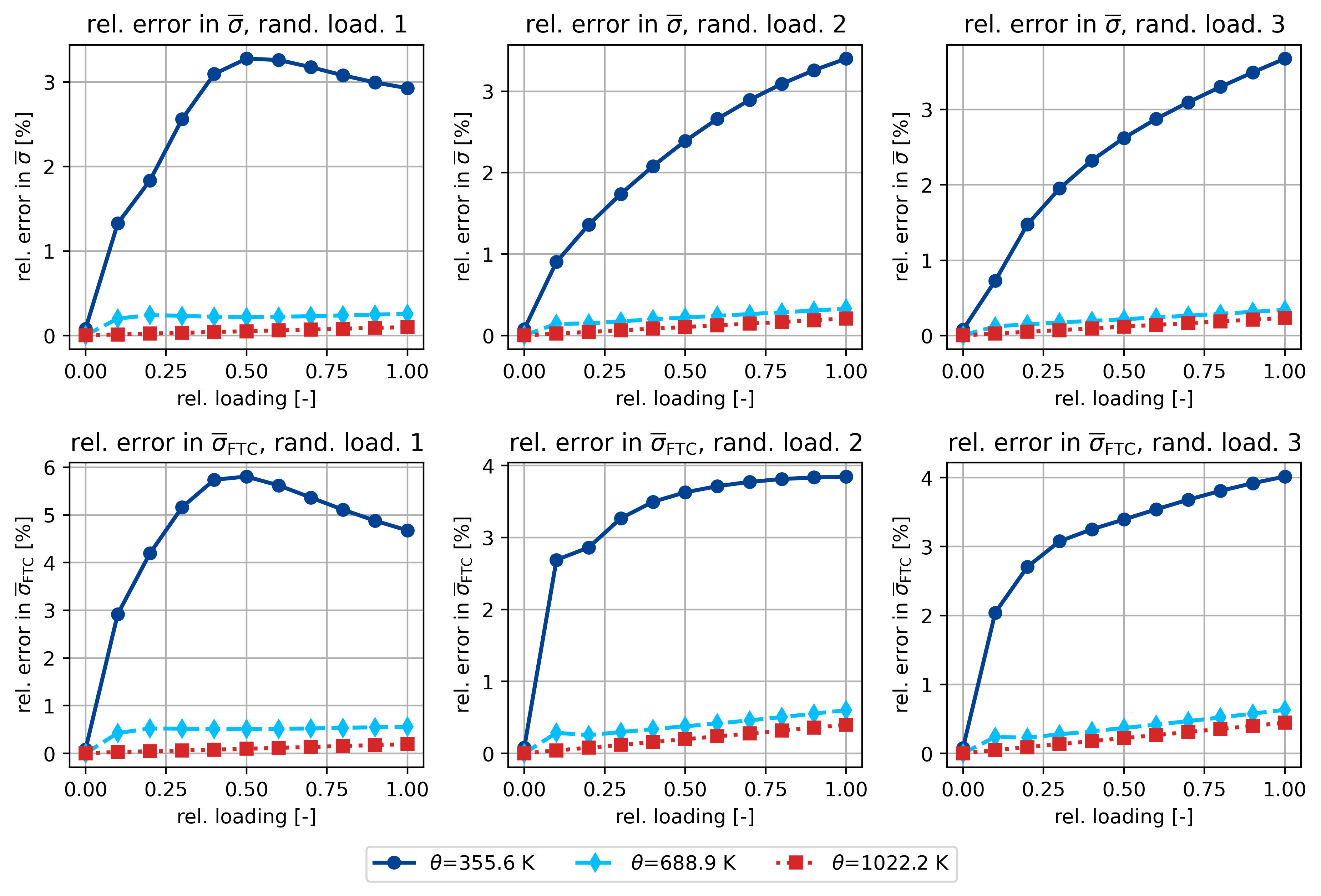
Uniaxial stress-driven simulation
[11]:
theta_list = np.linspace(300, 1300, 5)
eps_list = []
sig_list = []
sig0_list = []
sig1_list = []
q_list = []
xi_list = []
file_name = os.path.join(data_path, "ntfa", "ntfa_6loadings_10samples_N24.h5")
ntfa_material = ThermoMechNTFA(file_name, "/", sig_y=my_sig_y, N_max=24)
generate and store data
uniaxial stress loading for all 6 directions
starting from initial thermoelastic relaxed deformation state
[12]:
stress_file_name = os.path.join(data_path, "results", "uniaxial_stress_data.h5")
with h5py.File(stress_file_name, "w") as F:
for iload in range(6):
G = F.create_group(f"loading{iload:1d}")
# part 1: theta ramp up in 1 step
# part 2: add on top a uniaxial loading
for theta in theta_list:
eps_idx = np.array([iload])
sig_idx = np.setdiff1d(np.arange(6), eps_idx)
eps = np.zeros(6)
eps[eps_idx] = 1.0
eps = np.linspace(0, 0.02, 11)[:, None] * eps
ntfa_material.interpolate(theta)
# relaxed thermo-elastic strain
eps_th_el = -np.linalg.solve(ntfa_material.C, ntfa_material.s_th)
(
eps_initial,
sig_initial,
C_initial,
q_initial,
xi_initial,
) = ntfa_material.UMAT_mixed(
None,
np.zeros(6),
np.zeros(6),
np.zeros(6),
theta,
0.0,
np.zeros(ntfa_material.n_modes),
)
print("q_ini: ", q_initial, eps_initial - eps_th_el)
eps = eps + eps_initial
xi = np.zeros(ntfa_material.n_modes)
q = 0.0
C = np.zeros((6, 6))
np.set_printoptions(formatter=dict(float=lambda x: "%10.3g" % x))
sig = np.zeros_like(eps)
sig0 = np.zeros_like(eps)
sig1 = np.zeros_like(eps)
xi = np.zeros((eps.shape[0], ntfa_material.n_modes))
q = np.zeros(eps.shape[0])
q_n = 0
xi_n = np.zeros(ntfa_material.n_modes)
for i in range(eps.shape[0]):
if i == 0:
deps = eps[0].copy()
eps_n = np.zeros(6)
else:
deps = eps[i] - eps[i - 1]
eps_n = eps[i - 1]
eps[i], sig[i], C, q[i], xi[i] = ntfa_material.UMAT_mixed(
eps_idx, eps_n, deps, np.zeros(6), theta, q_n, xi_n
)
xi_n = xi[i].copy()
q_n = q[i]
sig0[i] = ntfa_material.stress(eps[i], theta, xi[i], i_phase=0)
sig1[i] = ntfa_material.stress(eps[i], theta, xi[i], i_phase=1)
eps_list.append(eps)
sig_list.append(sig)
sig0_list.append(sig0)
sig1_list.append(sig1)
xi_list.append(xi)
q_list.append(q)
GG = G.create_group(f"ntfa_T{theta:06.1f}")
GG.create_dataset("eps", data=eps)
GG.create_dataset("sig", data=sig)
GG.create_dataset("sig0", data=sig0)
GG.create_dataset("sig1", data=sig1)
GG.create_dataset("q", data=q)
GG.create_dataset("xi", data=xi)
q_ini: 0.0 [0. 0. 0. 0. 0. 0.]
q_ini: 0.0018869620045771874 [ 8.27e-05 7.42e-05 8.3e-05 -1.71e-05 -1.67e-05 -1.67e-05]
q_ini: 0.00755855857911729 [ 0.000363 0.000361 0.000354 -0.000125 -0.000125 -0.000125]
q_ini: 0.013277720241141709 [ 0.000754 0.000757 0.000775 -0.000273 -0.000274 -0.000274]
q_ini: 0.01685502141630085 [ 0.00138 0.00138 0.00139 -0.000249 -0.00025 -0.00025]
q_ini: 0.0 [ 0 0 0 0 0 0]
q_ini: 0.0018869620045771874 [ 8.27e-05 7.42e-05 8.3e-05 -1.71e-05 -1.67e-05 -1.67e-05]
q_ini: 0.00755855857911729 [ 0.000363 0.000361 0.000354 -0.000125 -0.000125 -0.000125]
q_ini: 0.013277720241141709 [ 0.000754 0.000757 0.000775 -0.000273 -0.000274 -0.000274]
q_ini: 0.01685502141630085 [ 0.00138 0.00138 0.00139 -0.000249 -0.00025 -0.00025]
q_ini: 0.0 [ 0 0 0 0 0 0]
q_ini: 0.0018869620045771874 [ 8.27e-05 7.42e-05 8.3e-05 -1.71e-05 -1.67e-05 -1.67e-05]
q_ini: 0.00755855857911729 [ 0.000363 0.000361 0.000354 -0.000125 -0.000125 -0.000125]
q_ini: 0.013277720241141709 [ 0.000754 0.000757 0.000775 -0.000273 -0.000274 -0.000274]
q_ini: 0.01685502141630085 [ 0.00138 0.00138 0.00139 -0.000249 -0.00025 -0.00025]
q_ini: 0.0 [ 0 0 0 0 0 0]
q_ini: 0.0018869620045771874 [ 8.27e-05 7.42e-05 8.3e-05 -1.71e-05 -1.67e-05 -1.67e-05]
q_ini: 0.00755855857911729 [ 0.000363 0.000361 0.000354 -0.000125 -0.000125 -0.000125]
q_ini: 0.013277720241141709 [ 0.000754 0.000757 0.000775 -0.000273 -0.000274 -0.000274]
q_ini: 0.01685502141630085 [ 0.00138 0.00138 0.00139 -0.000249 -0.00025 -0.00025]
q_ini: 0.0 [ 0 0 0 0 0 0]
q_ini: 0.0018869620045771874 [ 8.27e-05 7.42e-05 8.3e-05 -1.71e-05 -1.67e-05 -1.67e-05]
q_ini: 0.00755855857911729 [ 0.000363 0.000361 0.000354 -0.000125 -0.000125 -0.000125]
q_ini: 0.013277720241141709 [ 0.000754 0.000757 0.000775 -0.000273 -0.000274 -0.000274]
q_ini: 0.01685502141630085 [ 0.00138 0.00138 0.00139 -0.000249 -0.00025 -0.00025]
q_ini: 0.0 [ 0 0 0 0 0 0]
q_ini: 0.0018869620045771874 [ 8.27e-05 7.42e-05 8.3e-05 -1.71e-05 -1.67e-05 -1.67e-05]
q_ini: 0.00755855857911729 [ 0.000363 0.000361 0.000354 -0.000125 -0.000125 -0.000125]
q_ini: 0.013277720241141709 [ 0.000754 0.000757 0.000775 -0.000273 -0.000274 -0.000274]
q_ini: 0.01685502141630085 [ 0.00138 0.00138 0.00139 -0.000249 -0.00025 -0.00025]
run uniaxial strain controlled tests at different temperatures
the initial state is gained by ramping up the temperature from 293 K
subsequently, a strain controlled loading is superimposed in the iload-th component (2% loading).
[13]:
theta_list = np.linspace(300, 1300, 5)
eps_list = []
sig_list = []
sig0_list = []
sig1_list = []
q_list = []
xi_list = []
T_list = []
n_ramp = 10
stress_file_name_new = os.path.join(
data_path, "results", "ms9p_uniaxial_stress_data.h5"
)
with h5py.File(stress_file_name_new, "w") as F:
for iload in range(6):
G = F.create_group(f"loading{iload:1d}")
# part 1: theta ramp up in 5 steps
# part 2: add on top a uniaxial loading
for theta in theta_list:
eps_idx = np.array([iload])
sig_idx = np.setdiff1d(np.arange(6), eps_idx)
eps = np.zeros(6)
eps[eps_idx] = 1.0
# the actual loading we are seeking:
eps_bc = np.zeros((10 + n_ramp, 6))
eps_bc[(n_ramp - 1) :, eps_idx] = np.linspace(0, 0.02, 11)[:, None]
deps0 = np.zeros(6)
deps0[iload] = 0.02 / 10.0
# part 1: ramp up theta from 293 K to theta
T = np.zeros(n_ramp + 10)
theta_ramp = np.linspace(293.0, theta, n_ramp)
T[:n_ramp] = theta_ramp
T[n_ramp:] = theta
xi = np.zeros(ntfa_material.n_modes)
q = 0.0
C = np.zeros((6, 6))
np.set_printoptions(formatter=dict(float=lambda x: "%10.3g" % x))
eps = np.zeros_like(eps_bc)
sig = np.zeros_like(eps)
sig0 = np.zeros_like(eps)
sig1 = np.zeros_like(eps)
xi = np.zeros((eps.shape[0], ntfa_material.n_modes))
q = np.zeros(eps.shape[0])
q_n = 0.0
xi_n = np.zeros(ntfa_material.n_modes)
for i in range(eps.shape[0]):
t = T[i]
if i == 0:
deps = np.zeros(6)
eps_n = np.zeros(6)
else:
eps_n = eps[i - 1].copy()
if i >= n_ramp:
deps[:] = deps0[:]
if i < n_ramp:
# this induces stress free loading with free strains
eps_idx = None
else:
eps_idx = np.array([iload])
eps[i], sig[i], C, q[i], xi[i] = ntfa_material.UMAT_mixed(
eps_idx, eps_n, deps, np.zeros(6), t, q_n, xi_n
)
xi_n = xi[i].copy()
q_n = q[i]
sig0[i] = ntfa_material.stress(eps[i], t, xi[i], i_phase=0)
sig1[i] = ntfa_material.stress(eps[i], t, xi[i], i_phase=1)
# print(t, eps[i], q[i])
if i == n_ramp - 1:
# update the BC!
eps_bc[n_ramp:, :] += eps[n_ramp - 1][None, :]
eps_list.append(eps)
sig_list.append(sig)
sig0_list.append(sig0)
sig1_list.append(sig1)
xi_list.append(xi)
T_list.append(T)
q_list.append(q)
# print(f"ntfa_T{theta:06.1f}")
GG = G.create_group(f"ntfa_T{theta:06.1f}")
GG.create_dataset("T", data=T)
GG.create_dataset("eps", data=eps)
GG.create_dataset("sig", data=sig)
GG.create_dataset("sig0", data=sig0)
GG.create_dataset("sig1", data=sig1)
GG.create_dataset("q", data=q)
GG.create_dataset("xi", data=xi)
Load results from FE simulation on the microscale
The in-house FE simulation software stores the simulation results (homogenized overall stress sig, homogenized stress in cu phase sig_cu, homogenized stress in ftc phase sig_ftc, and homogenized hardening variable qbar) on the microscale in a new HDF5 (.h5) file. These results serve as validation data for the two-scale simulation at the specific integration point of the macroscale simulation.
[14]:
def rel_error(A, A_ref, r_min=None):
if r_min is None:
return np.linalg.norm(A - A_ref, axis=1) / np.linalg.norm(A_ref, axis=1)
else:
return np.linalg.norm(A - A_ref, axis=1) / np.maximum(
r_min, np.linalg.norm(A_ref, axis=1)
)
def rel_error_fixed(A, A_ref, r):
return np.linalg.norm(A - A_ref, axis=1) / r
sig_fe_list = []
sig0_fe_list = []
sig1_fe_list = []
with h5py.File(
os.path.join(data_path, "ms9p_uniaxial_stress_data_mod_fe.h5"), "r"
) as F:
for k in [0, 1, 2, 3, 4]:
temp = theta_list[np.mod(k, 5)]
iload = int(k / 5)
sig_fe = np.array(F[f"loading{iload}/ntfa_T{temp:06.1f}/fe_sig"])
sig0_fe = np.array(F[f"loading{iload}/ntfa_T{temp:06.1f}/fe_sig0"])
sig1_fe = np.array(F[f"loading{iload}/ntfa_T{temp:06.1f}/fe_sig1"])
sig_fe_list.append(sig_fe)
sig0_fe_list.append(sig0_fe)
sig1_fe_list.append(sig1_fe)
fig, ax = plt.subplots(1, 2, figsize=(plot_width, 3.0))
sig_ref = np.max(np.abs(sig_fe[:, iload]))
sig_ref0 = np.max(np.abs(sig0_fe[:, iload]))
sig_ref1 = np.max(np.abs(sig1_fe[:, iload]))
fig.suptitle(
rf"$T={temp}$ K - rel. error, $\mathcal{E}_\mathsf{{mat,xx}} = "
+ r"\vert \overline{\sigma}_\mathsf{mat,NTFA,xx} - \overline{\sigma}_\mathsf{mat,FE,xx} \vert \,/ \, "
+ r"\overline{\sigma}_\mathsf{{mat,FE,xx}} \,, \; \mathsf{mat} \in \{\mathsf{Cu}, \mathsf{FTC} \}$"
)
c1 = ntfa_material.v_frac[0]
c2 = ntfa_material.v_frac[1]
sig_list[k] = c1 * sig0_list[k] + c2 * sig1_list[k]
err_sig = np.abs(sig_list[k][:, iload] - sig_fe[:, iload]) / sig_ref
err_sig0 = np.abs(sig0_list[k][:, iload] - sig0_fe[:, iload]) / sig_ref0
err_sig1 = np.abs(sig1_list[k][:, iload] - sig1_fe[:, iload]) / sig_ref1
t = np.linspace(0, 2, sig_list[k][:].shape[0] + 1)[1:]
ax[0].plot(t[:], err_sig0[:] * 100)
ax[1].plot(t[:], err_sig1[:] * 100)
for z, A in enumerate(ax.ravel()):
A.grid()
A.set_xlabel("rel. time [-]")
if z == 0:
A.set_ylabel(r"$\mathcal{E}_\mathsf{{Cu,xx}}$ [%]")
else:
A.set_ylabel(r"$\mathcal{E}_\mathsf{{FTC,xx}}$ [%]")
A.set_ylim([0, 6])
ax[0].text(
0.65, 5.25, "plastic CU matrix", backgroundcolor=colors[0], color="white"
)
ax[1].text(
0.65,
5.25,
"elastic FTC particles",
backgroundcolor=colors[0],
color="white",
)
fig.tight_layout()
plt.savefig(
os.path.join(data_path, "figures", f"rel_error_uniaxial_T{temp:.0f}.pdf")
)





Figuring when plasticity kicks in using the mixed UMAT
set the stress to 0
ramp the temperature from 293K
check for q >= q_crit_0, q_crit_1, e.g. q_crit_0 = 0.002 (i.e. 0.2%)
draw the results of theta
[15]:
n_ramp = 1300 - 293 + 1
thermal_rampup_file = os.path.join(data_path, "loadcases", "ms9p_thermal_rampup.h5")
with h5py.File(thermal_rampup_file, "w") as F:
eps_idx = None
sig_idx = np.arange(6)
eps = np.zeros(6)
# the actual loading we are seeking:
eps_bc = np.zeros((n_ramp, 6))
# part 1: ramp up theta from 293 K to theta
T = np.linspace(293.0, 1300.0, n_ramp)
q = 0.0
C = np.zeros((6, 6))
np.set_printoptions(formatter=dict(float=lambda x: "%10.3g" % x))
eps = np.zeros_like(eps_bc)
sig = np.zeros_like(eps)
sig0 = np.zeros_like(eps)
sig1 = np.zeros_like(eps)
xi = np.zeros((eps.shape[0], ntfa_material.n_modes))
q = np.zeros(eps.shape[0])
q_n = 0.0
xi_n = np.zeros(ntfa_material.n_modes)
for i in range(eps.shape[0]):
t = T[i]
if i == 0:
deps = eps_bc[0].copy()
eps_n = np.zeros(6)
else:
deps = eps_bc[i] - eps[i - 1]
eps_n = eps[i - 1]
eps[i], sig[i], C, q[i], xi[i] = ntfa_material.UMAT_mixed(
eps_idx, eps_n, deps, np.zeros(6), t, q_n, xi_n
)
xi_n = xi[i].copy()
q_n = q[i]
sig0[i] = ntfa_material.stress(eps[i], t, xi[i], i_phase=0)
sig1[i] = ntfa_material.stress(eps[i], t, xi[i], i_phase=1)
F.create_dataset("T", data=T)
F.create_dataset("eps", data=eps)
F.create_dataset("sig", data=sig)
F.create_dataset("sig0", data=sig0)
F.create_dataset("sig1", data=sig1)
F.create_dataset("q", data=q)
F.create_dataset("xi", data=xi)
[16]:
q_crit = [1e-5, 0.002, 0.005, 0.01]
with h5py.File(thermal_rampup_file, "r") as F:
q = np.array(F["q"])
T = np.array(F["T"])
eps = np.array(F["eps"])
sig0 = np.array(F["sig0"])
sig1 = np.array(F["sig1"])
fig, ax = plt.subplots(1, 1, figsize=(12, 7))
ax.plot(T, 100 * q, color=colors[1], lw=2, label=r"NTFA $\overline{q}$", marker="")
for qc in q_crit:
ax.plot([T[0], T[-1]], [100 * qc, 100 * qc], color="black", lw=1, marker="")
i = np.searchsorted(q, qc)
ax.annotate(
text=rf"$q_c={qc*100}\%$\n$T={T[i]}\mathrm{{K}}$",
xy=[T[i], 100 * q[i]],
xytext=[T[i] - 145, 100 * q[i] + 0.23],
color=colors[0],
arrowprops={"width": 1.5, "color": colors[0]},
zorder=100000,
)
ax.grid()
ax.set_xlim(T[0], T[-1])
ax.set_xlabel(r"temperature $T$ [$\mathrm{K}$]")
ax.set_ylabel(r"hardening variable $\overline{q}$ [%]")
plt.show()
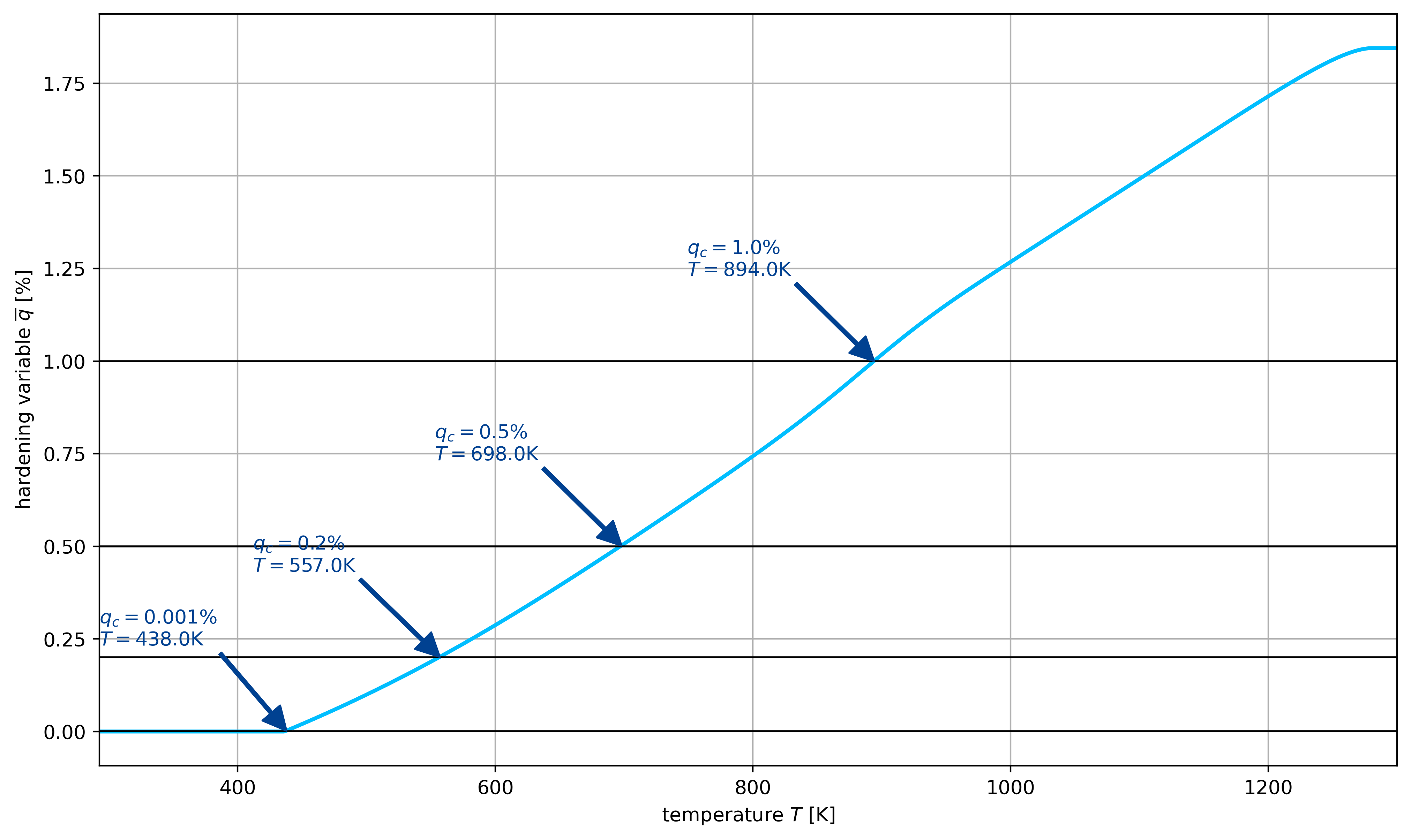
Twoscale simulation
Analysis of the two-scale simulation
determine an element in the notch
extract the strain, temperature, stress, qbar, xi, sig_cu, sig_ftc history
pass the strain, temperature history to FANS as BC
Compare the results
[17]:
fe_fine_file = os.path.join(data_path, "results", "NTFA293K_fine_temp_293-800.h5")
with h5py.File(fe_fine_file, "r") as F:
# step 1: find the element with the crucial pieces of information
# read mesh
vx = np.array(F["/mesh/X"]).reshape((-1, 3))
el = np.array(F["/mesh/el_vx_idx"]).reshape((-1, 10))
n_el = np.array(F["/mesh/n_el"])[0]
n_vx = np.array(F["/mesh/n_vx"])[0]
gp_idx = np.array(F["/mesh/DPIdx"])
# get element centers
el_center = np.zeros((n_el, 3))
for i_el in range(n_el):
el_center[i_el, :] = np.mean(vx[el[i_el, :], :], axis=0)
# find the element center closest to 0., 2.5, 0.
dist = np.linalg.norm(el_center - np.array([5.0, 0, 2.5])[None, :], axis=1)
i_min = np.argmin(dist)
print(
f"element closest to [5., 0., 2.5]: {i_min} with element center {el_center[i_min]}"
)
element closest to [5., 0., 2.5]: 10819 with element center [ 4.42 -0.5 2.5]
Load results of simulation on the macroscale with NTFA material model
In the following, we look at the simulation results at the integration point at the vicinity of the noth (at the center of the specimen)
[18]:
with h5py.File(fe_fine_file, "r") as F:
N_modes = 24
n_inc = 32
theta = np.zeros(n_inc + 1)
eps = np.zeros((n_inc + 1, 6))
sig = np.zeros((n_inc + 1, 6))
sig_cu = np.zeros((n_inc + 1, 6))
sig_ftc = np.zeros((n_inc + 1, 6))
qbar = np.zeros(n_inc + 1)
xi = np.zeros((n_inc + 1, N_modes))
zeta = np.zeros((n_inc + 1, N_modes + 7))
idat_start = np.array(F["/Data/step1/n_iD"][: gp_idx[i_min]]).sum()
idat_end = idat_start + F["/Data/step1/n_iD"][gp_idx[i_min]]
n_gp = F["/Data/step1/n_gp"][0]
theta = np.array(F[f"/temperature{n_inc}"])
force = np.array(F[f"/force{n_inc}"])
for i in range(n_inc):
j = i + 1
cdat = np.array(F[f"/Data/step{i+1}/cData"][gp_idx[i_min]])
eps[j, :] = cdat[:6]
sig[j, :] = cdat[6:]
idat = np.array(F[f"/Data/step{i+1}/iData"])[idat_start:idat_end]
xi[j, :] = idat[1 : (N_modes + 1)]
qbar[j] = idat[0]
zeta[j, :6] = eps[j, :]
zeta[j, 6] = 1
zeta[j, 7:] = xi[j, :]
# reconstruct the phase-wise stresses
sig_cu[j, :] = A_cu.interpolate(theta[j]) @ zeta[j, :]
sig_ftc[j, :] = A_ftc.interpolate(theta[j]) @ zeta[j, :]
Use temperature and strain as boundary conditions for FE simulation on the microscale
Save the temperature theta and strain eps from the macroscopic simulation to an HDF5 (.h5) file. This information is then read by an in-house simulation software that performs a FE simulation on the microscale for this specific integration point. Therein, theta and eps from the macroscopic simulation are used as boundary conditions/loadings.
[19]:
bc_file_name = os.path.join(data_path, "loadcases", "twoscale_notch.h5")
F = h5py.File(bc_file_name, "w")
F.create_dataset("/sig", data=sig) # only used for comparison later on
F.create_dataset("/sig_cu", data=sig_cu) # only used for comparison later on
F.create_dataset("/sig_ftc", data=sig_ftc) # only used for comparison later on
F.create_dataset("/eps", data=eps)
F.create_dataset("/theta", data=theta)
F.create_dataset("/time", data=t)
F.close()
Load results from FE simulation on the microscale
The in-house FE simulation software stores the simulation results (homogenized overall stress sig, homogenized stress in cu phase sig_cu, homogenized stress in ftc phase sig_ftc, and homogenized hardening variable qbar) on the microscale in a new HDF5 (.h5) file. These results serve as validation data for the two-scale simulation at the specific integration point of the macroscale simulation.
[20]:
sim_bc_file_name = os.path.join(data_path, "results", "twoscale_notch_rve.h5")
with h5py.File(sim_bc_file_name, "r") as F:
fe_eps = np.array(F["/eps"])
fe_theta = np.array(F["/theta"])
fe_sig = np.array(F["/rve/sig"])
fe_sig_cu = np.array(F["/rve/sig0"])
fe_sig_ftc = np.array(F["/rve/sig1"])
fe_qbar = np.array(F["/rve/qbar"]).ravel()
Compute some stress information (hydrostatic stress, equivalent stress, principal normal stresses)
[21]:
sig_h = sig[:, :3].sum(axis=1) / 3
sig_h_cu = sig_cu[:, :3].sum(axis=1) / 3
sig_h_ftc = sig_ftc[:, :3].sum(axis=1) / 3
fe_sig_h = fe_sig[:, :3].sum(axis=1) / 3
fe_sig_h_cu = fe_sig_cu[:, :3].sum(axis=1) / 3
fe_sig_h_ftc = fe_sig_ftc[:, :3].sum(axis=1) / 3
sig_eq = np.sqrt(
1.5 * np.maximum(0.0, np.linalg.norm(sig, axis=1) ** 2 - 3 * sig_h * sig_h)
)
sig_eq_cu = np.sqrt(
1.5 * np.maximum(0.0, np.linalg.norm(sig_cu, axis=1) ** 2 - 3 * sig_h_cu * sig_h_cu)
)
sig_eq_ftc = np.sqrt(
1.5
* np.maximum(0.0, np.linalg.norm(sig_ftc, axis=1) ** 2 - 3 * sig_h_ftc * sig_h_ftc)
)
fe_sig_eq = np.sqrt(
1.5 * np.maximum(0.0, np.linalg.norm(fe_sig, axis=1) ** 2 - 3 * sig_h * sig_h)
)
fe_sig_eq_cu = np.sqrt(
1.5
* np.maximum(
0.0, np.linalg.norm(fe_sig_cu, axis=1) ** 2 - 3 * fe_sig_h_cu * sig_h_cu
)
)
fe_sig_eq_ftc = np.sqrt(
1.5
* np.maximum(
0.0, np.linalg.norm(fe_sig_ftc, axis=1) ** 2 - 3 * fe_sig_h_ftc * sig_h_ftc
)
)
sig_I_ftc = np.zeros(sig.shape[0])
sig_II_ftc = np.zeros(sig.shape[0])
sig_III_ftc = np.zeros(sig.shape[0])
sig_I_cu = np.zeros(sig.shape[0])
sig_II_cu = np.zeros(sig.shape[0])
sig_III_cu = np.zeros(sig.shape[0])
for i in range(n_inc + 1):
sig_III_cu[i], sig_II_cu[i], sig_I_cu[i] = np.linalg.eigvalsh(Vec2Tensor(sig_cu[i]))
sig_III_ftc[i], sig_II_ftc[i], sig_I_ftc[i] = np.linalg.eigvalsh(
Vec2Tensor(sig_ftc[i])
)
fe_sig_I_ftc = np.zeros(sig.shape[0])
fe_sig_II_ftc = np.zeros(sig.shape[0])
fe_sig_III_ftc = np.zeros(sig.shape[0])
fe_sig_I_cu = np.zeros(sig.shape[0])
fe_sig_II_cu = np.zeros(sig.shape[0])
fe_sig_III_cu = np.zeros(sig.shape[0])
for i in range(n_inc + 1):
fe_sig_III_cu[i], fe_sig_II_cu[i], fe_sig_I_cu[i] = np.linalg.eigvalsh(
Vec2Tensor(fe_sig_cu[i])
)
fe_sig_III_ftc[i], fe_sig_II_ftc[i], fe_sig_I_ftc[i] = np.linalg.eigvalsh(
Vec2Tensor(fe_sig_ftc[i])
)
[22]:
t = np.linspace(0, 2, n_inc + 1)
fig, ax = plt.subplots(1, 2, figsize=(plot_width, 3.5))
ax[0].plot(
fe_eps[:, 1],
fe_sig[:, 1] / 1000,
color=colors[0],
marker=markers[0],
label=r"$\overline{\sigma}_{\sf yy}^{\mathrm{FE}}$",
)
ax[0].plot(
eps[:, 1],
sig[:, 1] / 1000,
":",
color=colors[1],
marker=markers[1],
label=r"$\overline{\sigma}_{\sf yy}^{\mathrm{NTFA}}$",
)
ax[0].plot(
fe_eps[:, 1],
fe_sig_cu[:, 1] / 1000,
"-",
color=colors[2],
marker=markers[2],
label=r"$\overline{\sigma}_{\sf Cu, yy}^{\mathrm{FE}}$",
)
ax[0].plot(
eps[:, 1],
sig_cu[:, 1] / 1000,
":",
color=colors[3],
marker=markers[3],
label=r"$\overline{\sigma}_{\sf Cu, yy}^{\mathrm{NTFA}}$",
)
ax[0].plot(
fe_eps[:, 1],
fe_sig_ftc[:, 1] / 1000,
"-",
color=colors[4],
marker=markers[4],
label=r"$\overline{\sigma}_{\sf FTC, yy}^{\mathrm{FE}}$",
)
ax[0].plot(
eps[:, 1],
sig_ftc[:, 1] / 1000,
":",
color=colors[5],
marker=markers[5],
label=r"$\overline{\sigma}_{\sf FTC, yy}^{\mathrm{NTFA}}$",
)
ax[0].set_title(
r"$\overline{\sigma}_{\sf yy}$, $\overline{\sigma}_{\sf Cu, yy}$,"
+ r"$\overline{\sigma}_{\sf FTC, yy}$ vs. $\overline{\varepsilon}_{\sf yy}$"
)
# ax[0].legend()
ax[0].grid()
ax[0].set_xlabel(r"$\overline{\varepsilon}_{\sf yy}$ [-]")
ax[0].set_ylabel(
r"$\overline{\sigma}_{\sf yy}, \overline{\sigma}_{\sf Cu, yy}, \overline{\sigma}_{\sf FTC, yy}$ [MPa]"
)
eyy_max = max(eps[:, 1])
syy = sig[int(n_inc / 2), 1] / 1000
syy_cu = sig_cu[int(n_inc / 2), 1] / 1000
syy_ftc = sig_ftc[int(n_inc / 2), 1] / 1000
# arrowprops = dict(shrink=0.02, facecolor='black', shrinkB=1, width=2, headwidth=12, headlength=12)
arrowprops = dict(arrowstyle="-|>", shrinkB=1, shrinkA=50)
# ax[0].annotate("start\nunloading &\ncool down", xy=(eyy_max,syy), xytext=(0.02,925), arrowprops=arrowprops)
# ax[0].annotate("", xy=(eyy_max, syy_cu), xytext=(0.0275, 975), arrowprops=arrowprops)
# ax[0].annotate("", xy=(eyy_max, syy_ftc), xytext=(0.0315, 1050), arrowprops=arrowprops)
# ax[0].plot(eyy_max, syy_cu, "d", color="red", ms=10)
# ax[0].plot(eyy_max, syy_ftc, "d", color="blue", ms=10)
# ax[0].plot(eyy_max, syy, "d", color="black", ms=10)
ax[1].plot((1, 1), (-100, 900), lw=2, color="gray")
ax[1].text(1.05, -140, "unload & cool down")
ax[1].annotate(
"",
xy=(1.25, 0),
xytext=(1, 0),
arrowprops=dict(
facecolor="black", shrink=0.0, width=2, headwidth=12, headlength=12
),
)
ax[1].plot(
t, fe_sig[:, 1] / 1000, "-", color=colors[0], marker=markers[0]
) # , label=r"$\overline{\sigma}_{\sf yy}^{\mathrm{FE}}$")
ax[1].plot(
t, sig[:, 1] / 1000, ":", color=colors[1], marker=markers[1]
) # , label=r"$\overline{\sigma}_{\sf yy}^{\mathrm{NTFA}}$")
ax[1].plot(
t, fe_sig_cu[:, 1] / 1000, "-", color=colors[2], marker=markers[2]
) # , label=r"$\overline{\sigma}_{\sf Cu,yy}^{\mathrm{FE}}$")
ax[1].plot(
t, sig_cu[:, 1] / 1000, ":", color=colors[3], marker=markers[3]
) # , label=r"$\overline{\sigma}_{\sf Cu,yy}^{\mathrm{NTFA}}$")
ax[1].plot(
t, fe_sig_ftc[:, 1] / 1000, "-", color=colors[4], marker=markers[4]
) # , label=r"$\overline{\sigma}_{\sf FTC,yy}^{\mathrm{FE}}$")
ax[1].plot(
t, sig_ftc[:, 1] / 1000, ":", color=colors[5], marker=markers[5]
) # , label=r"$\overline{\sigma}_{\sf FTC,yy}^{\mathrm{NTFA}}$")
ax[1].set_title(
r"$\overline{\sigma}_{\sf yy}$, $\overline{\sigma}_{\sf Cu, yy}$,"
+ r"$\overline{\sigma}_{\sf FTC, yy}$, $\overline{Q}$ vs. time $t$"
)
ax2 = ax[1].twinx()
ax[1].grid()
ax2.plot(
t, fe_qbar, "-", color=colors[6], marker="p", label=r"$\overline{Q}^{\mathrm{FE}}$"
)
ax2.plot(
t,
qbar,
":",
color=colors[7],
marker="*",
label=r"$\overline{Q}^{\mathrm{NTFA}}$",
)
ax[1].set_xlabel(r"$t$ [s]")
ax[1].set_ylabel(
r"$\overline{\sigma}_{\sf yy}, \overline{\sigma}_{\sf Cu, yy}, \overline{\sigma}_{\sf FTC, yy}$ [MPa]"
)
ax2.set_ylabel(r"$\overline{Q}$ [-]")
# ax[1].legend(loc="center right")
fig.legend(ncol=8, loc="lower center", bbox_to_anchor=(0, -0.09, 1, 1))
plt.tight_layout()
plt.savefig(
os.path.join(data_path, "figures", "notchtest_fine_sigyy_ntfa.pdf"),
format="pdf",
bbox_inches="tight",
)
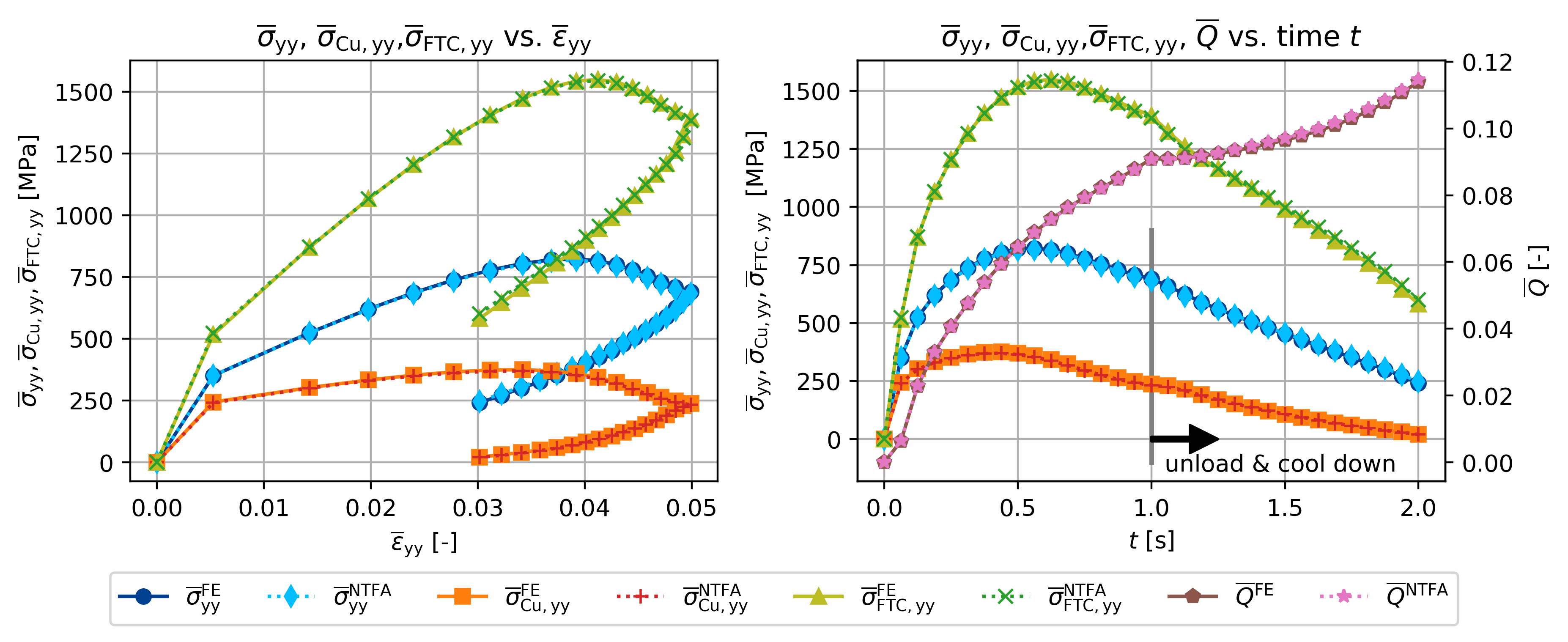
[23]:
fig, ax = plt.subplots(1, 2, figsize=(plot_width, 3.5))
ax[0].plot(
t,
fe_sig_I_ftc / 1000,
"-", # fe_sig_III_ftc
color=colors[0],
marker=markers[0],
label=r"$\overline{\sigma}_{\sf FTC, 1}^{\mathrm{FE}}$",
)
ax[0].plot(
t,
sig_I_ftc / 1000,
":", # sig_III_ftc
color=colors[1],
marker=markers[1],
label=r"$\overline{\sigma}_{\sf FTC, 1}^{\mathrm{NTFA}}$",
)
ax[0].plot(
t,
fe_sig_II_ftc / 1000,
"-", # fe_sig_II_ftc
color=colors[2],
marker=markers[2],
label=r"$\overline{\sigma}_{\sf FTC, 2}^{\mathrm{FE}}$",
)
ax[0].plot(
t,
sig_II_ftc / 1000,
":", # sig_II_ftc
color=colors[3],
marker=markers[3],
label=r"$\overline{\sigma}_{\sf FTC, 2}^{\mathrm{NTFA}}$",
)
ax[0].plot(
t,
fe_sig_III_ftc / 1000,
"-", # fe_sig_I_ftc
color=colors[4],
marker=markers[4],
label=r"$\overline{\sigma}_{\sf FTC, 3}^{\mathrm{FE}}$",
)
ax[0].plot(
t,
sig_III_ftc / 1000,
":", # sig_I_ftc
color=colors[5],
marker=markers[5],
label=r"$\overline{\sigma}_{\sf FTC, 3}^{\mathrm{NTFA}}$",
)
ax[0].plot(
t,
fe_sig_I_cu / 1000,
"-", # fe_sig_III_cu
color=colors[6],
marker=markers[6],
label=r"$\overline{\sigma}_{\sf Cu, 1}^{\mathrm{FE}}$",
)
ax[0].plot(
t,
sig_I_cu / 1000,
":", # sig_III_cu
color=colors[7],
marker=markers[7],
label=r"$\overline{\sigma}_{\sf Cu, 1}^{\mathrm{NTFA}}$",
)
ax[0].plot(
t,
fe_sig_II_cu / 1000,
"-", # fe_sig_II_cu
color=colors[8],
marker=markers[8],
label=r"$\overline{\sigma}_{\sf Cu, 2}^{\mathrm{FE}}$",
)
ax[0].plot(
t,
sig_II_cu / 1000,
":", # sig_II_cu
color=colors[9],
marker=markers[9],
label=r"$\overline{\sigma}_{\sf Cu, 2}^{\mathrm{NTFA}}$",
)
ax[0].plot(
t,
fe_sig_III_cu / 1000,
"-", # fe_sig_I_cu
color=colors[10],
marker=markers[10],
label=r"$\overline{\sigma}_{\sf Cu, 3}^{\mathrm{FE}}$",
)
ax[0].plot(
t,
sig_III_cu / 1000,
":", # sig_I_cu
color=colors[11],
marker=markers[11],
label=r"$\overline{\sigma}_{\sf Cu, 3}^{\mathrm{NTFA}}$",
)
# ax[0].legend(ncol=1) # loc='center right')
ax[0].grid()
ax[0].set_xlabel(r"$t$ [s]")
ax[0].set_ylabel(r"Principal normal stress [MPa]")
ax[0].plot((1, 1), (-200, 900), lw=2, color="gray")
ax[0].text(1.05, 500, "unload & cool down")
ax[0].annotate(
"",
xy=(1.25, 400),
xytext=(1, 400),
arrowprops=dict(
facecolor="black", shrink=0.0, width=2, headwidth=12, headlength=12
),
)
fig.legend(ncol=6, loc="lower left", bbox_to_anchor=(0, -0.15, 1, 1))
sig_y = np.zeros_like(t)
for i, T in enumerate(theta):
sig_y[i] = my_sig_y(T, qbar[i])
ax[1].plot((1, 1), (-100, 900), lw=2, color="gray")
ax[1].text(1.05, 500, "unload & cool down")
ax[1].annotate(
"",
xy=(1.25, 400),
xytext=(1, 400),
arrowprops=dict(
facecolor="black", shrink=0.0, width=2, headwidth=12, headlength=12
),
)
# ax[1].plot(t, sig_h_cu/1000, '-', color='red', label=r"$\overline{\sigma}_{\sf Cu, h}$")
ax[1].plot(
t, sig_eq_cu / 1000, "-", color=colors[0], label=r"$\overline{\sigma}_{\sf Cu, eq}$"
)
# ax[1].plot(t, sig_h_ftc/1000, '-', color='blue', label=r"$\overline{\sigma}_{\sf FTC, h}$")
ax[1].plot(
t,
sig_eq_ftc / 1000,
"-",
color=colors[1],
label=r"$\overline{\sigma}_{\sf FTC, eq}$",
)
ax[1].plot(
t, sig_y / 1000, "-", color=colors[3], label=r"$\sigma_{\sf y}(\overline{Q})$"
)
ax[1].legend(ncol=1, loc="upper right")
ax[1].grid()
ax[1].set_xlabel(r"$t$ [s]")
ax[1].set_ylabel(r"Equivalent stress, yield stress [MPa]")
fig.tight_layout()
fig.savefig(
os.path.join(data_path, "figures", "notchtest_fine_sigeq_ntfa.pdf"),
format="pdf",
bbox_inches="tight",
)
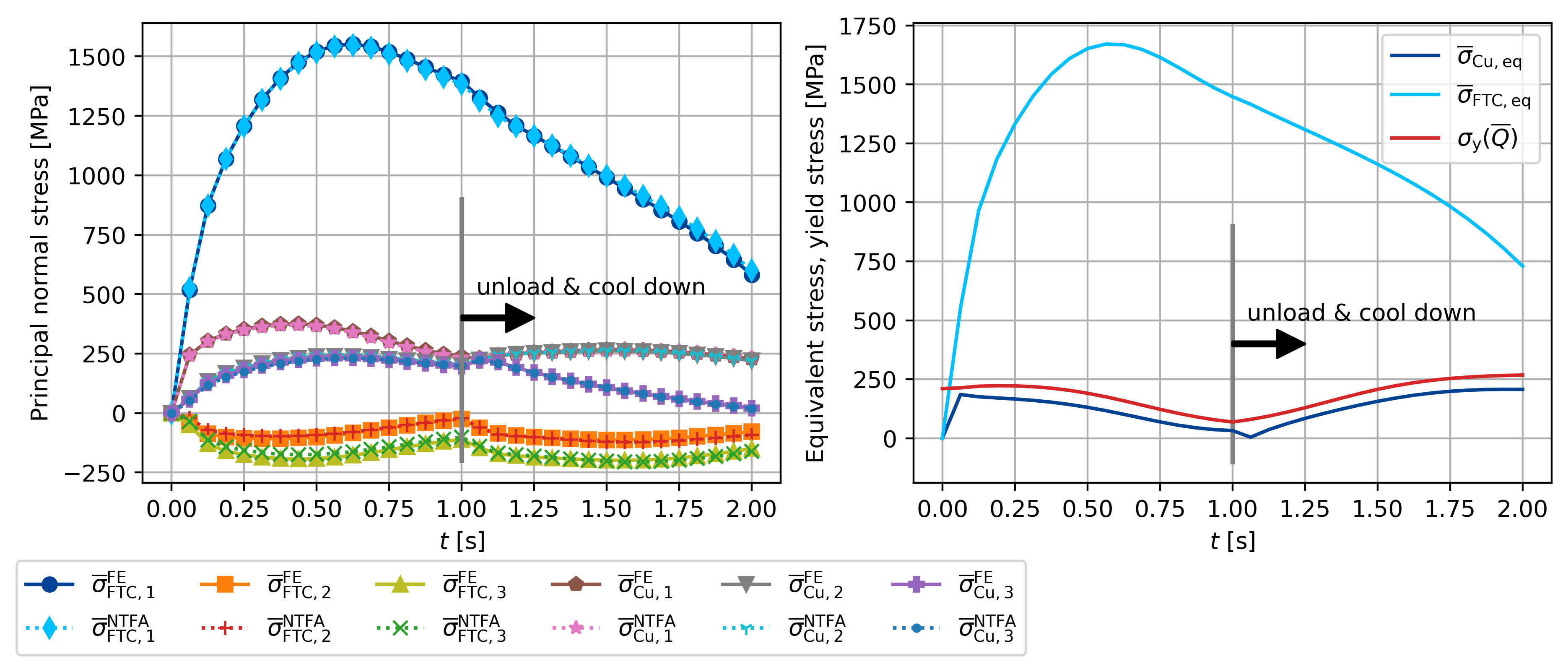
[24]:
force = []
temp = []
for s in ("coarse", "fine"): # 'medium',
with h5py.File(
os.path.join(data_path, f"vtk-notch/NTFA293K_{s}_temp_293-800.h5"), mode="r"
) as F:
force.append(np.array(F["force32"]) / 1e6)
temp.append(np.array(F["temperature32"]))
fig, ax = plt.subplots(1, 1, figsize=(7.5, 5))
labels = False
for f, T in zip((force), (temp)):
t = np.linspace(0, 2, f.size)
ax.plot(t, f, "-s", ms=4, label="tensile force", color=colors[0])
if labels:
ax.plot(1.0, f[np.where(t == 1.0)], "o", color="black", ms=6)
else:
ax2 = ax.twinx()
nhalf = int((t.size + 1) / 2)
# ax.plot(1.0, f[np.where(t==1.0)], 'o', color='black', ms=6, label='start unloading', zorder=4)
ax.fill_between(
t[:nhalf], f[:nhalf], np.zeros(nhalf), color=colors[0], alpha=0.2, zorder=2
)
ax.fill_between(
t[(nhalf - 1) :],
f[(nhalf - 1) :],
np.zeros(f.size - nhalf + 1),
color=colors[1],
alpha=0.2,
zorder=2,
)
ax2.plot(t, T, "-s", ms=4, color=colors[2], zorder=4, label="temperature")
ax.set_xlabel("time [s]")
ax.set_ylabel("force [kN]")
ax2.set_ylabel("temperature [K]")
ax.text(
0.4, 2, "tensile loading", color=colors[0], bbox=dict(facecolor="white")
)
ax.text(
1.1, 2, "force unloading", color=colors[1], bbox=dict(facecolor="white")
)
ax.grid(zorder=1)
ax.legend(loc=(0.65, 0.825))
ax2.legend(loc=(0.65, 0.7))
nhalf = int((t.size + 1) / 2)
labels = True
fig.savefig(os.path.join(data_path, "figures", "twoscale_loading.pdf"))
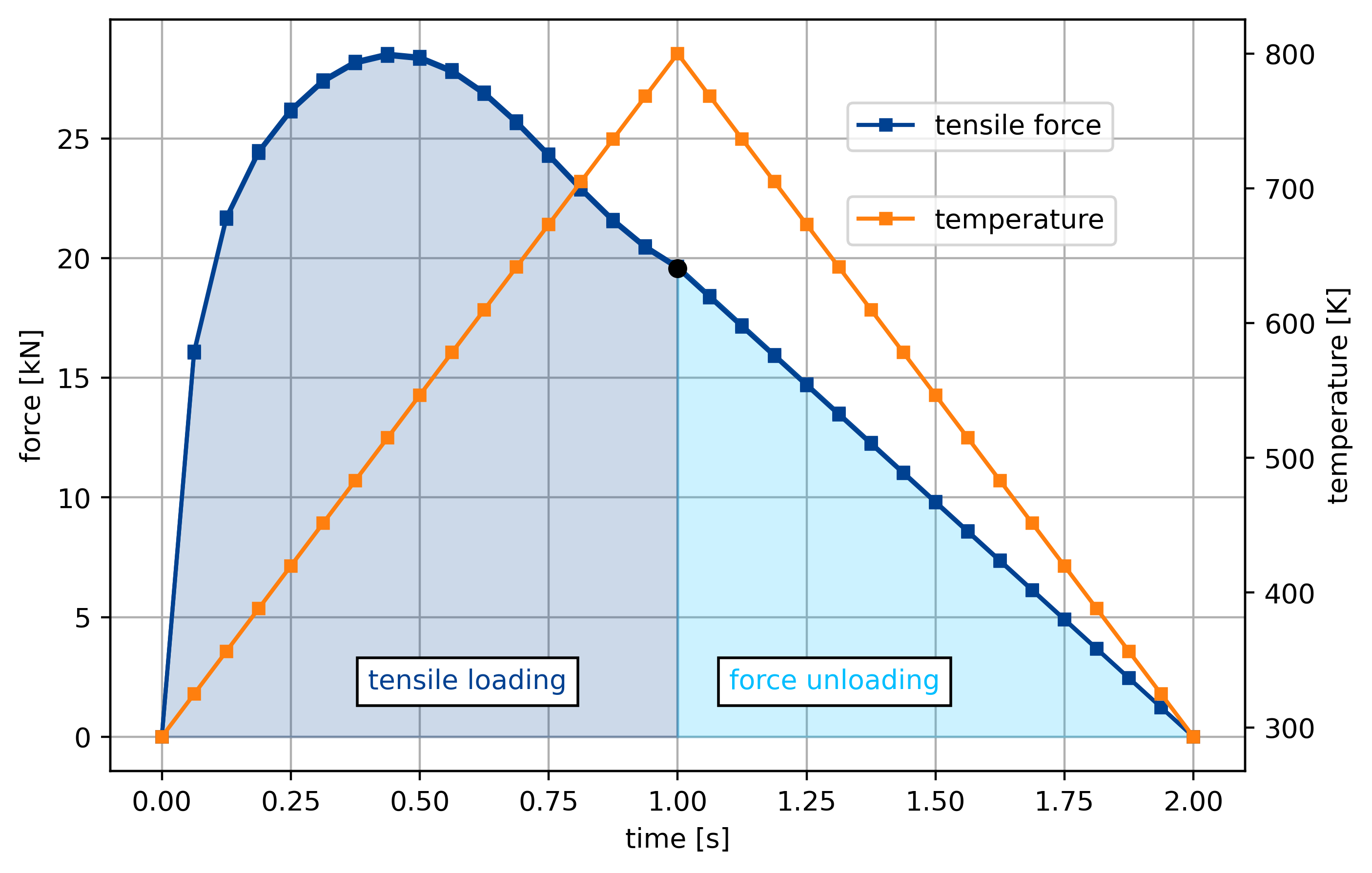
[25]:
fig, ax = plt.subplots(1, 1, figsize=(7.5, 5))
ax.plot((1.0, 1.0), (-0.05, 1.05), "--", color="gray", lw=2, zorder=4)
ax.fill_between(
(0.0, 1.0), (0.0, 1.0), (0.0, 0.0), color=colors[0], alpha=0.2, zorder=2
)
ax.fill_between(
(1.0, 2.0), (1.0, 0.0), (0.0, 0.0), color=colors[1], alpha=0.2, zorder=2
)
ax.plot((0.0, 1.0), (0.0, 1.0), color=colors[0], lw=2, zorder=1)
ax.plot((1.0, 2.0), (1.0, 0.0), "--", color=colors[1], lw=2, zorder=1)
ax.text(0.4, 0.1, "tensile loading", color=colors[0], bbox=dict(facecolor="white"))
ax.text(1.1, 0.1, "force unloading", color=colors[1], bbox=dict(facecolor="white"))
ax.set_xlabel("time [s]")
ax.set_ylabel(r"rel. stretch $u/u_\mathrm{max}$ and force $F/F_\mathrm{max}$ [-]")
ax.grid(zorder=3)
fig.savefig(os.path.join(data_path, "figures", "twoscale_loading2.pdf"))
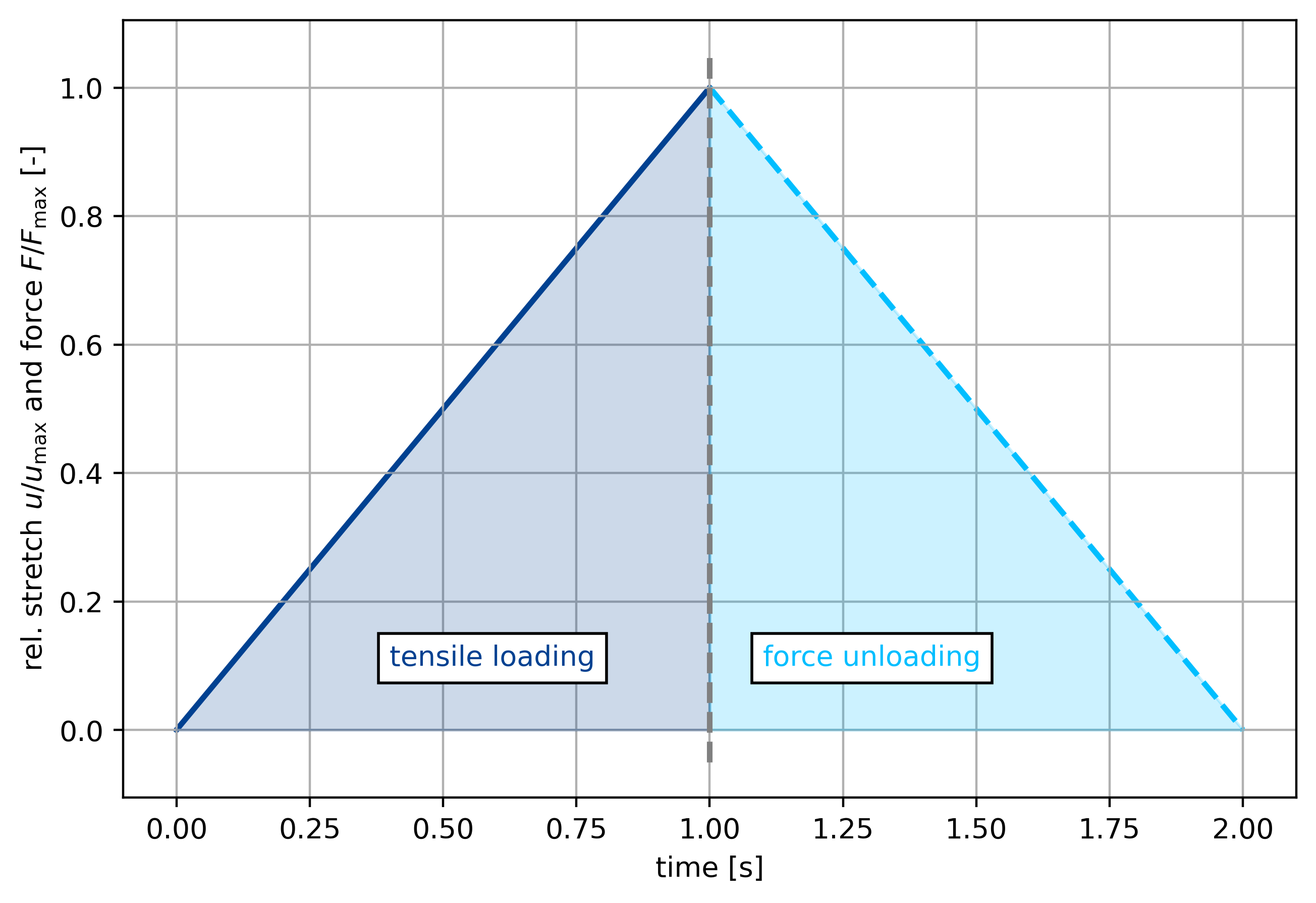
[ ]: